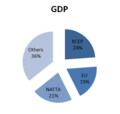North American Free Trade Agreement facts for kids
Quick facts for kids
North American Free Trade Agreement
|
|
|---|---|
| 1994–2020 | |
 |
|
| Languages | |
| Type | Free trade area |
| Member states | Canada United States Mexico |
| History | |
|
• Effective
|
January 1, 1994 |
|
• USMCA in force
|
July 1, 2020 |
| Area | |
|
• Total
|
21,578,137 km2 (8,331,365 sq mi) |
|
• Water (%)
|
7.4 |
| Population | |
|
• 2018 estimate
|
490,000,000 |
|
• Density
|
22.3/km2 (57.8/sq mi) |
| GDP (PPP) | 2018 estimate |
|
• Total
|
$24.8 trillion |
|
• Per capita
|
$50,700 |
The North American Free Trade Agreement (NAFTA) was a special deal between Canada, Mexico, and the United States. It created a big trade area in North America. This agreement started on January 1, 1994. It replaced an older trade deal between the U.S. and Canada from 1988. NAFTA became one of the world's largest trade areas based on how much money its countries made.
Contents
How NAFTA Started
The idea for a free trade zone in North America began with U.S. President Ronald Reagan. He talked about it during his 1980 election campaign.
Negotiating the Agreement
After the U.S. and Canada signed their own trade deal in 1988, leaders decided to expand it. U.S. President George H. W. Bush, Mexican President Carlos Salinas de Gortari, and Canadian Prime Minister Brian Mulroney worked together. They agreed to create what became NAFTA.
In December 1992, each country's leader sent the agreement to their government for approval. But many people in the United States and Canada were against NAFTA.
Making it Official
To get NAFTA approved, two more agreements were added in 1993. These were about protecting workers and the environment. After these additions, all three countries officially approved NAFTA.
What NAFTA Did
When NAFTA started, it removed or lowered many barriers between the U.S., Canada, and Mexico. These barriers are like taxes or rules that make it harder to trade goods and services between countries.
Effects of the Agreement
People had different ideas about how NAFTA would affect jobs, the environment, and the economy. Most experts who studied the economy believed NAFTA helped the economies of North America. They thought it was good for most people.
However, a small number of workers in certain industries faced problems. These were industries that suddenly had more competition from other countries. Economists generally agreed that ending NAFTA would hurt the U.S. economy and cost jobs. Mexico would have been much more affected by job losses and slower economic growth.
NAFTA's Replacement
In January 2017, U.S. President Donald Trump wanted to replace NAFTA. He started new talks with Canada and Mexico.
The USMCA Agreement
By September 2018, the United States, Mexico, and Canada agreed on a new deal. It was called the United States–Mexico–Canada Agreement (USMCA). All three countries approved it by March 2020.
NAFTA stayed in place until the USMCA officially began. In April 2020, Canada and Mexico told the U.S. they were ready. The USMCA took effect on July 1, 2020, replacing NAFTA. The new agreement included only small changes.
Images for kids
-
Back row, left to right: Mexican President Carlos Salinas de Gortari, U.S. President George H. W. Bush, and Canadian Prime Minister Brian Mulroney, at the initialing of the draft North American Free Trade Agreement in October 1992. In front are Mexican Secretary of Commerce and Industrial Development Jaime Serra Puche, United States Trade Representative Carla Hills, and Canadian Minister of International Trade Michael Wilson.
-
Obama, Peña Nieto and Harper at the IX North American Leaders' Summit (informally known as the Three Amigos Summit) in Toluca
-
Former President Enrique Peña Nieto with Prime Minister Justin Trudeau of Canada and then-President Barack Obama of the United States at the 2016 North American Leaders' Summit
-
Chrystia Freeland, Luis Videgaray Caso and Rex Tillerson in Mexico City in 2018
See also
 In Spanish: Tratado de Libre Comercio de América del Norte para niños
In Spanish: Tratado de Libre Comercio de América del Norte para niños







